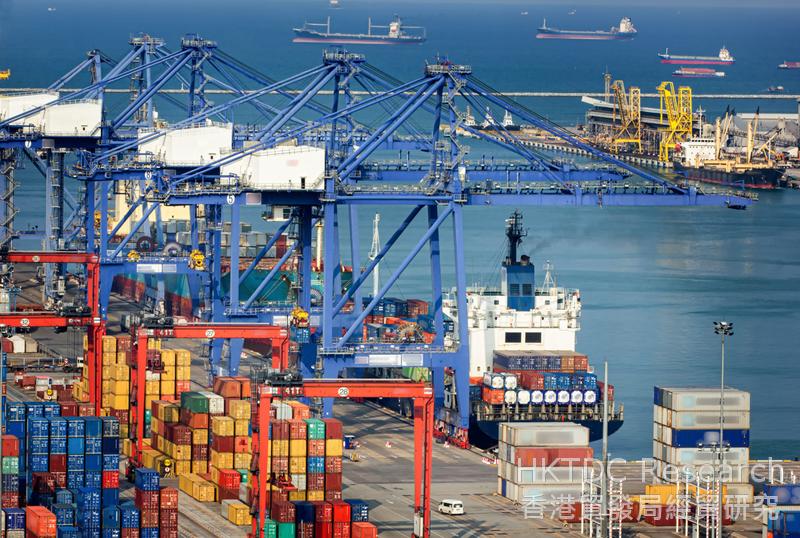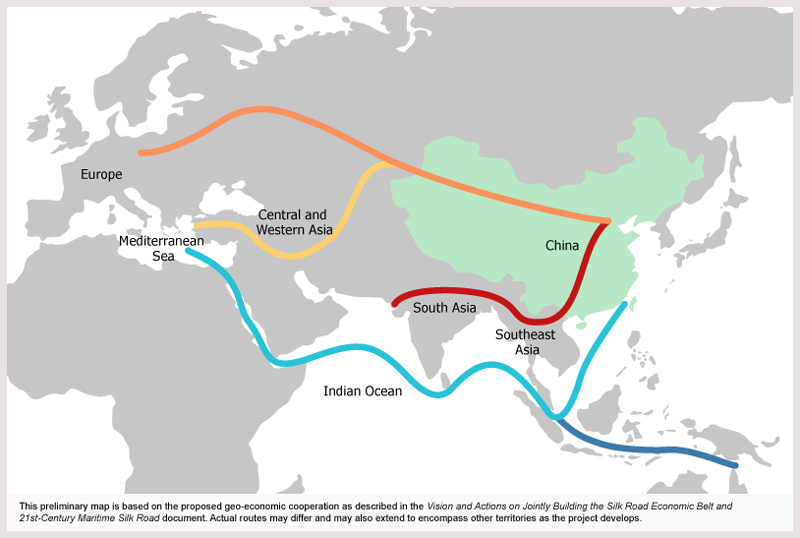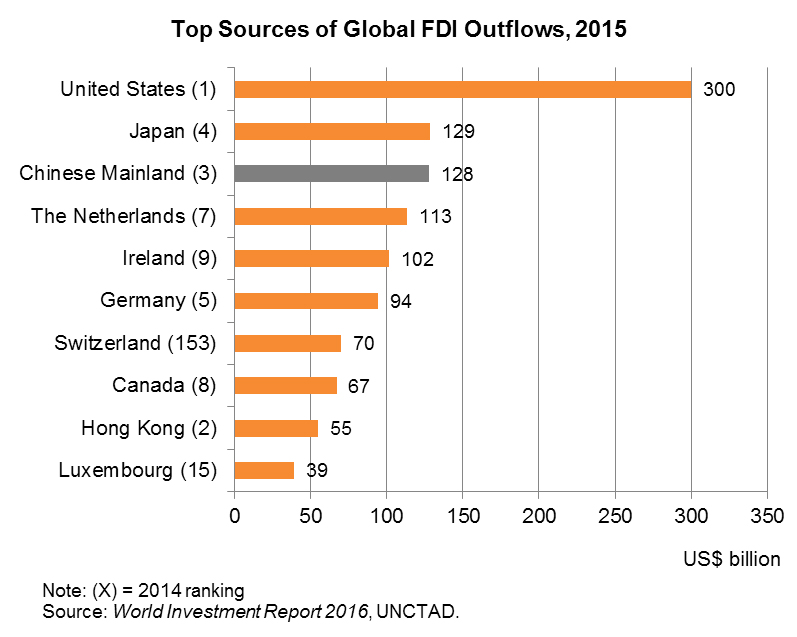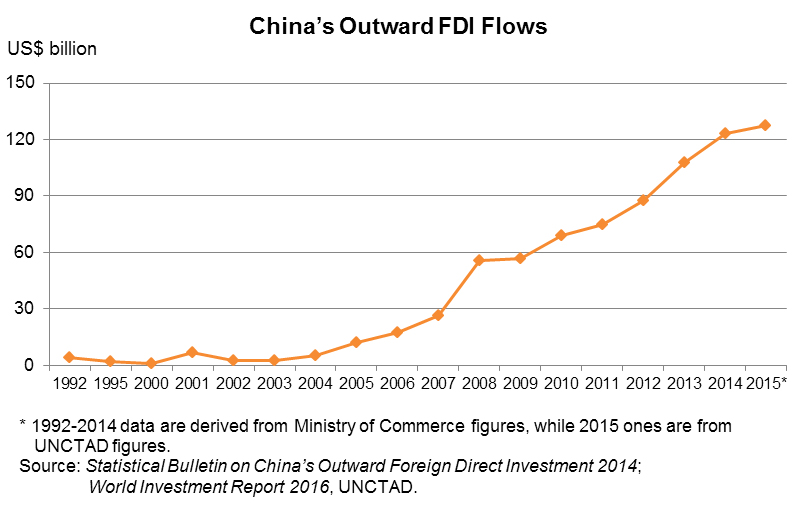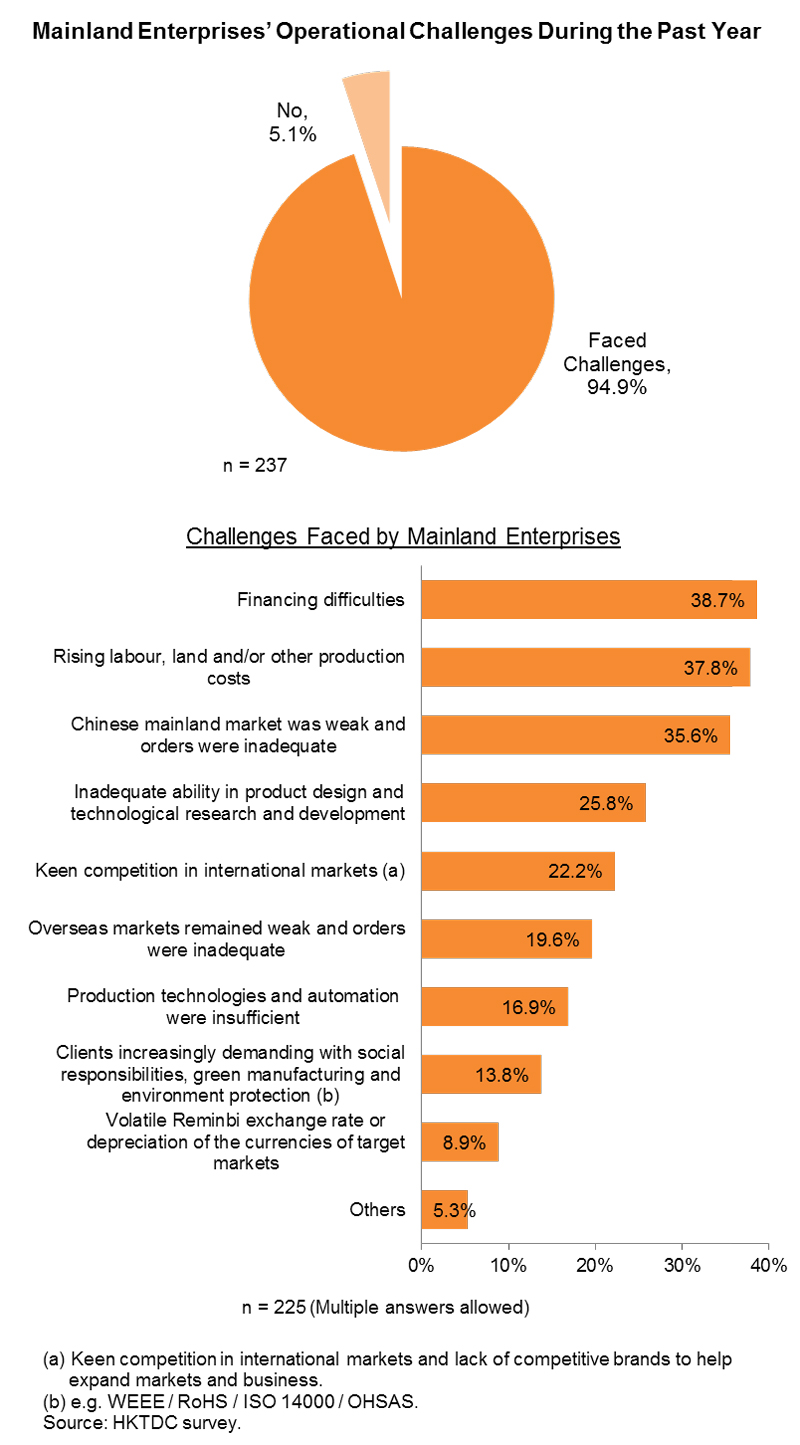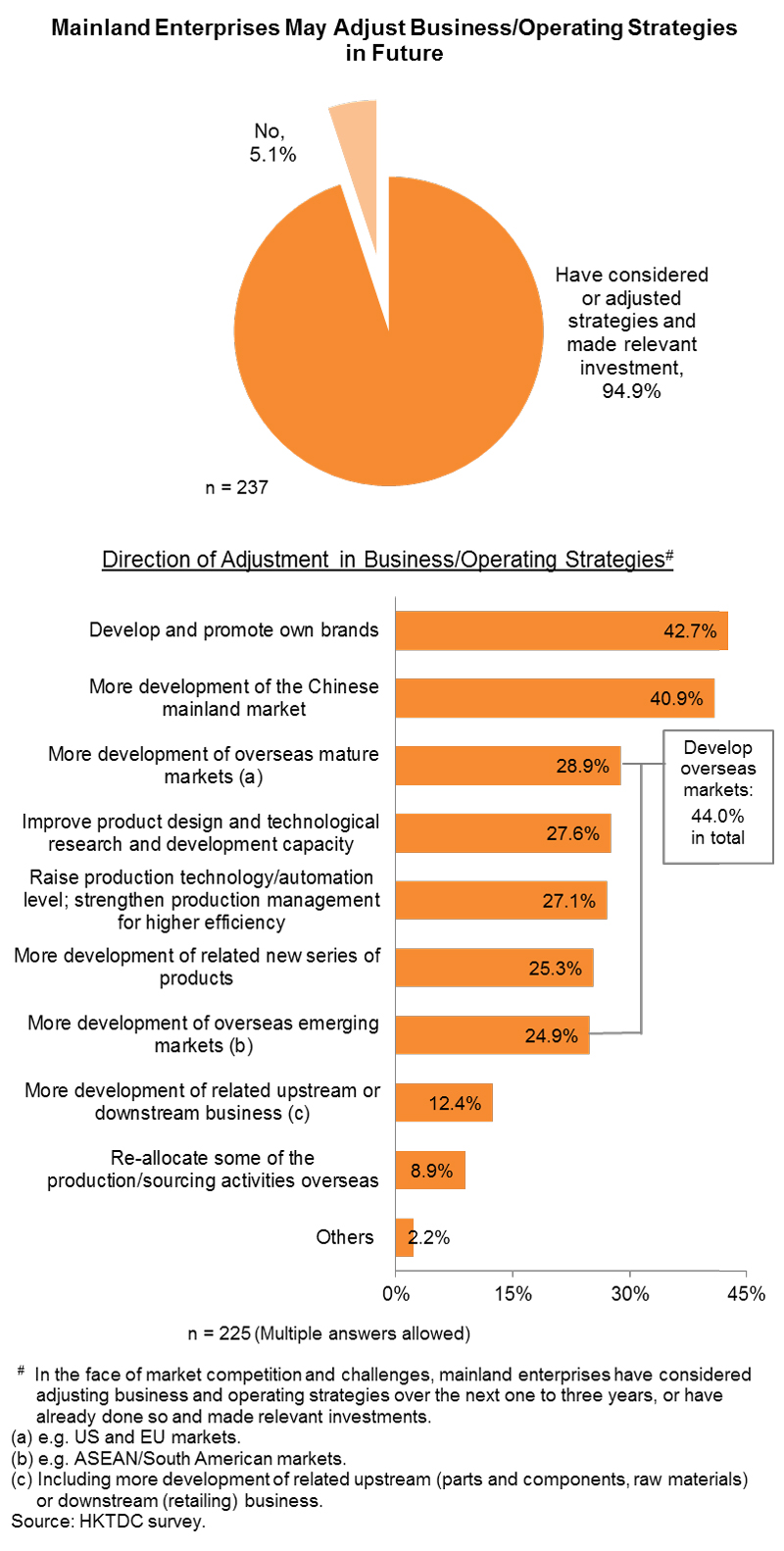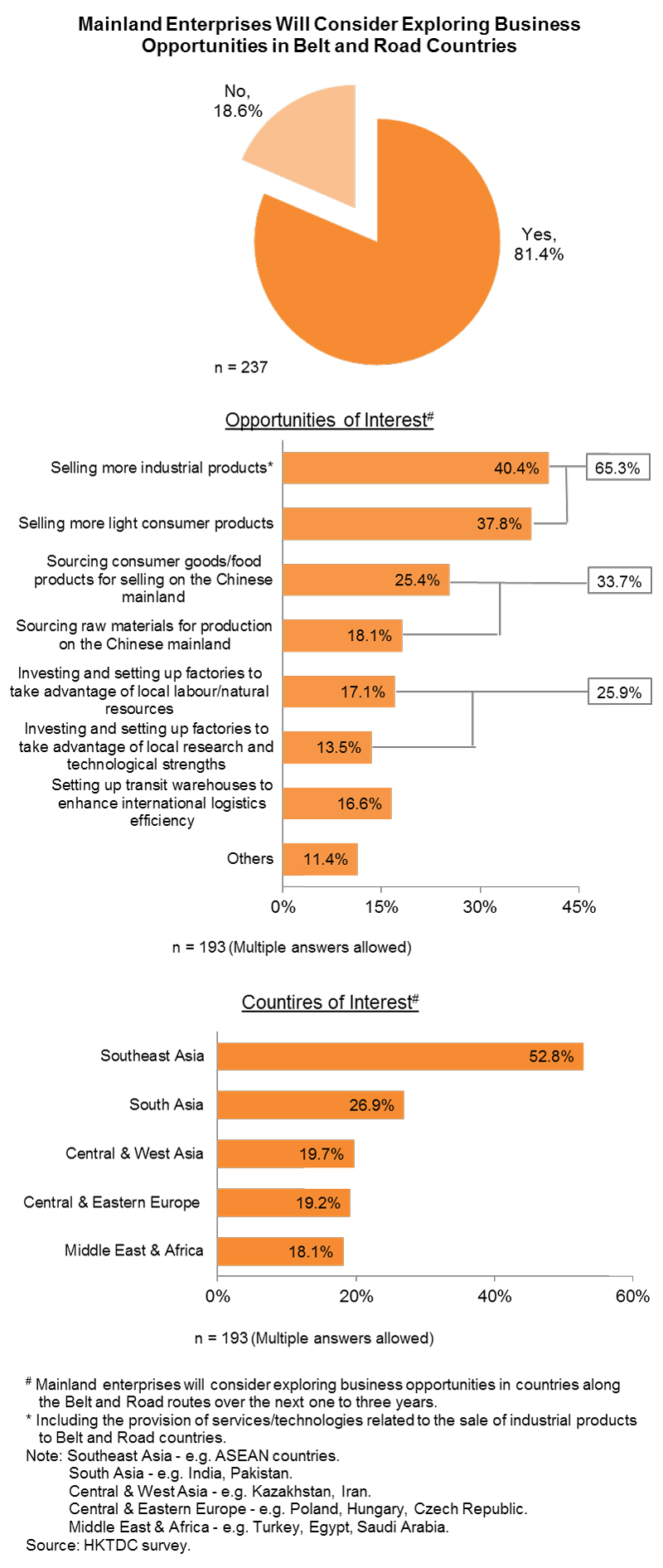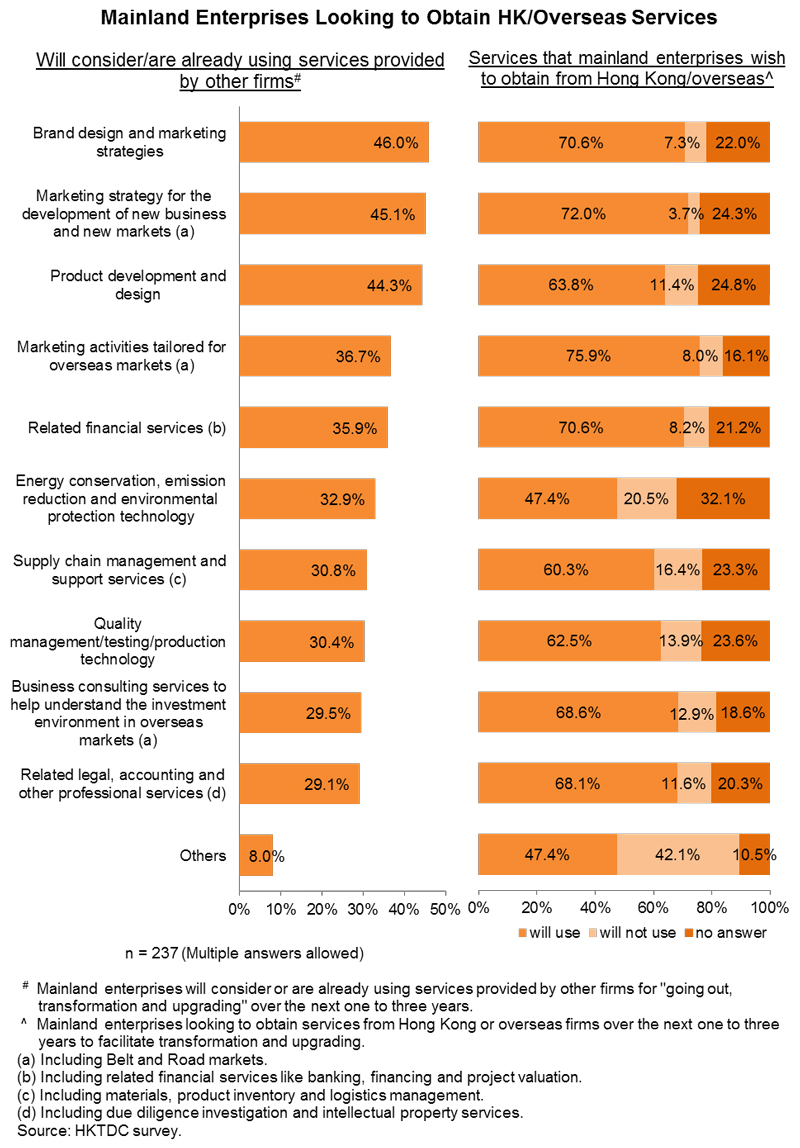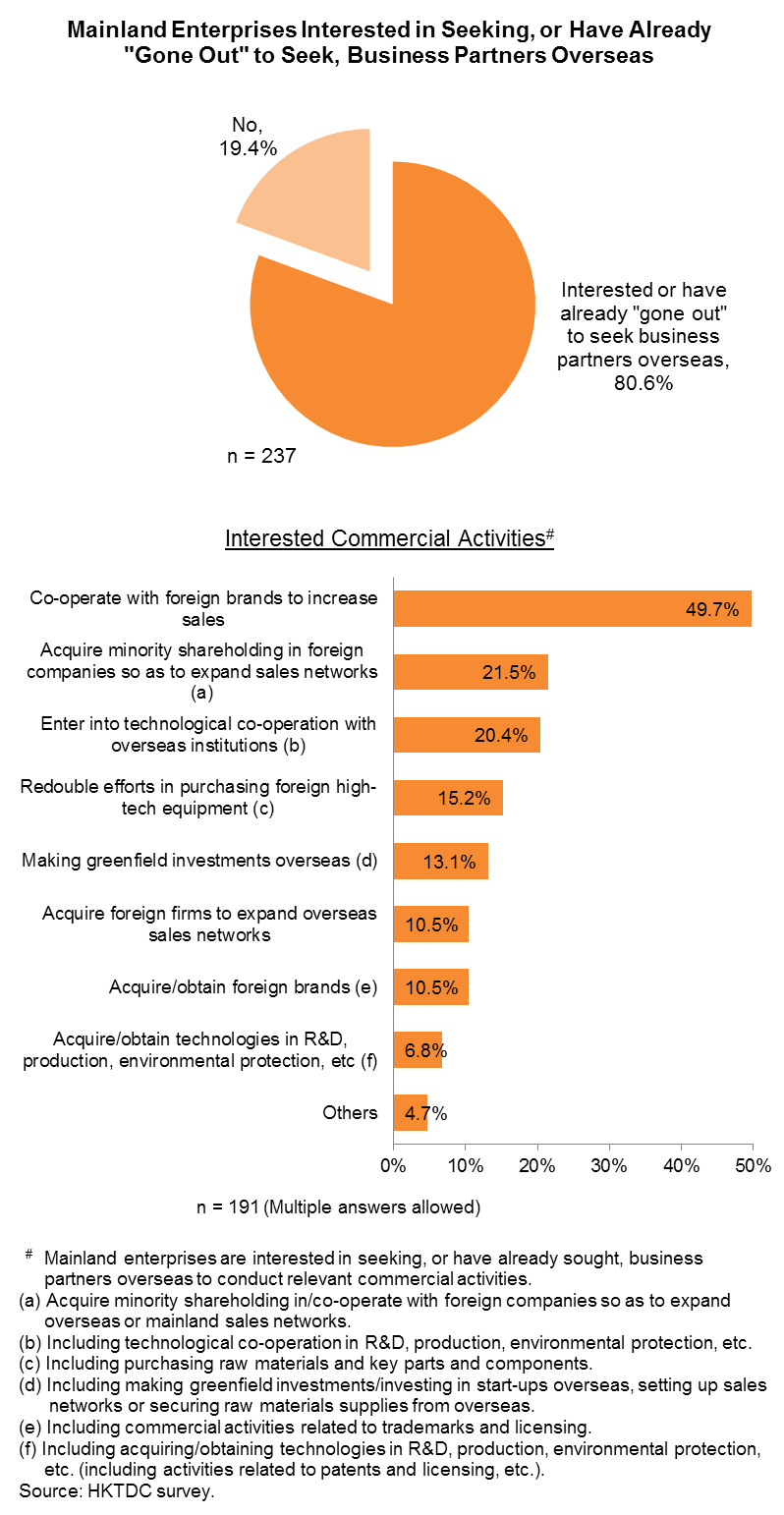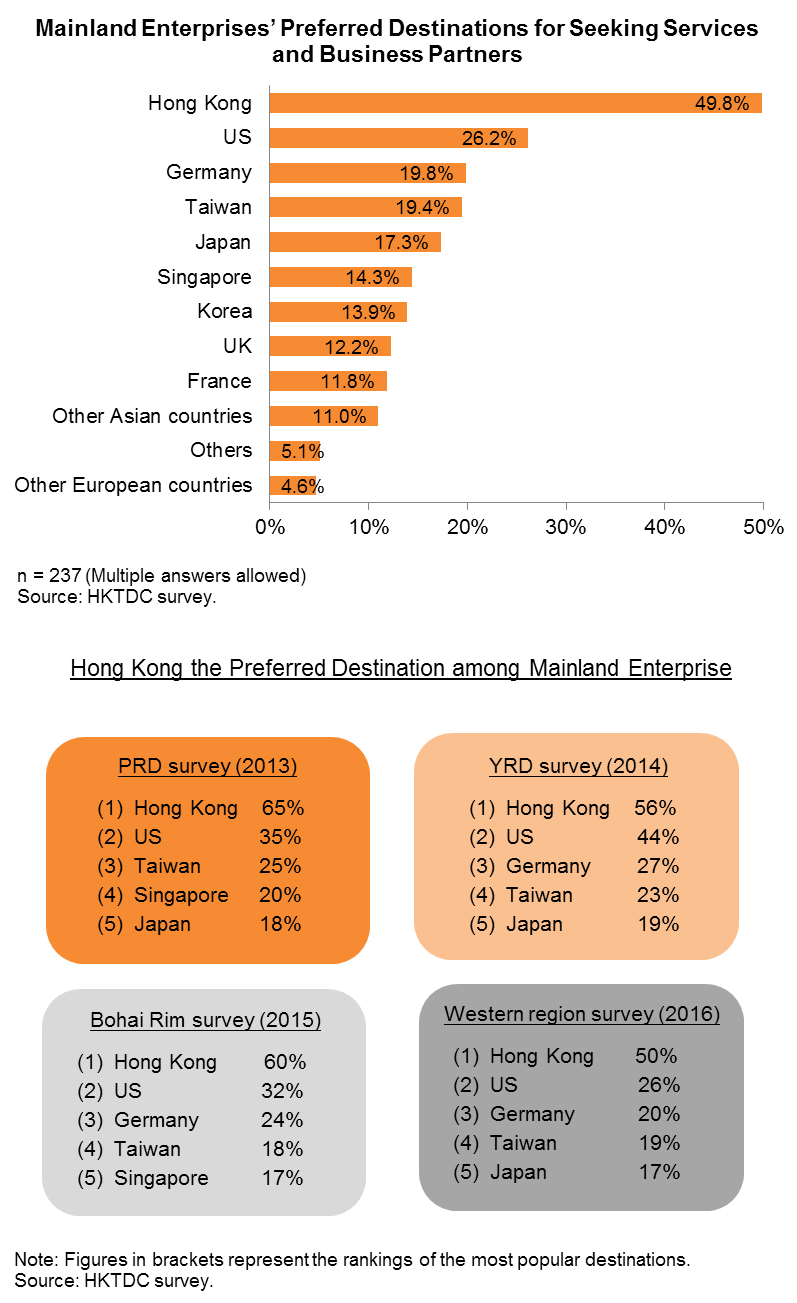China's “Going Out” Initiative: Service Demand of Western China to Tap Belt and Road Opportunities
China's “Going Out” Initiative: Service Demand of Western China to Tap Belt and Road Opportunities
Thanks to the active overseas investment of Chinese enterprises in recent years and the Chinese government’s advancement of the Belt and Road Initiative, China was the world’s third-largest source of foreign investment for the fourth consecutive year in 2015. In fact, many mainland enterprises are stepping up their efforts in “going out” to look for brands, technologies and other resources to boost their competitiveness, while bringing in the advantages of foreign partners as a way to further develop Chinese and overseas markets.
HKTDC Research recently conducted a questionnaire survey with enterprises in western China. The results reveal that in order to deal with such challenges as securing financing, escalating production costs and market slowdowns, mainland enterprises are keen to seek outside professional services to help them achieve transformation and upgrading. These range from brand design and promotion strategies, to marketing and product research and development (R&D), to financial and legal services.
Moreover, the majority of enterprises surveyed said they would consider “going out” further to tap business opportunities in countries along the Belt and Road routes, particularly in ASEAN countries and other Southeast Asian markets. As well as aiming to sell more industrial/light consumer products to Belt and Road markets, they also wish to carry out sourcing and investment activities such as setting up factories.
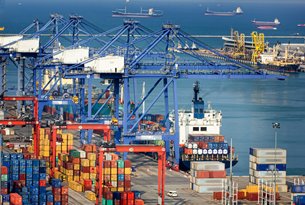
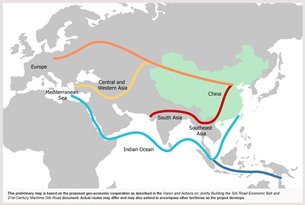
The largest proportion of the surveyed enterprises (50%) said that, in the course of “going out”, they would be most interested in going to Hong Kong to seek professional supporting services and business partners. This is in line with the results of similar surveys carried out by HKTDC Research in the past three years, namely in the Pearl River Delta (PRD) in 2013, the Yangtze River Delta (YRD) in 2014 and the Bohai Rim in 2015. Therefore, whether in the coastal regions or in western China, it is apparent that Hong Kong is the preferred services platform for mainland enterprises intent on “going out”.
New Pattern of Opening Up Under the 13th Five-Year Plan
China is not only a leading destination for foreign direct investment (FDI), but it also ranks among the world’s top sources of FDI. Indeed, China has in recent years significantly relaxed its administrative measures on outbound investment in order to facilitate the “going out” of enterprises to invest overseas. Furthermore, the Belt and Road Initiative strengthens mutually beneficial co-operation with countries along its economic corridors.
Adopted in March 2016, China’s 13th Five-Year Plan[1] stresses the need to establish a new pattern of all-round opening up in the next five years (2016-2020). It encourages enterprises to “go out” to establish sales networks in foreign markets and to bring in the advantages of foreign partners to enhance competitiveness. Meanwhile, bilateral and multilateral co-operation mechanisms will be improved to encourage co-operation and investment in countries along the Belt and Road routes, infrastructure connectivity and trade facilitation advanced, and co-operation in energy and industry chains strengthened. It can therefore be expected that China’s outbound investment activities will see further expansion.
(For further details, please see Opportunities Arising from China’s 13th Five-Year Plan: An Overview.)
The World’s Third-Largest FDI Source
According to the latest United Nations Conference on Trade and Development (UNCTAD) figures[2], for four straight years since 2012 China has been the world’s third-largest source of FDI. China’s total outward FDI flows have increased from US$123.1 billion in 2014 to about US$127.6 billion in 2015, trailing only the United States (US$300 billion) and Japan (US$128.7 billion).
Although China has entered into a “new normal” of slower economic growth in the past few years, it has gradually become a main investor in certain developed countries. In particular, investment through cross-border mergers and acquisitions has been increasing, and has moved away from the previous pattern of focusing on energy and natural resources to a diversified pattern covering wholesale and retail, transportation and shipping/warehousing, and real property development. Furthermore, many Chinese enterprises have engaged with their foreign partners in co-operation projects involving technology, or are carrying out various types of commercial co-operation activities with foreign brands, as a way to further develop Chinese and overseas markets.
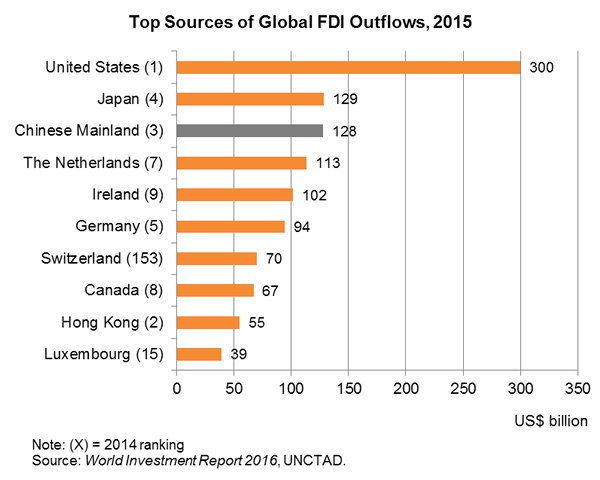
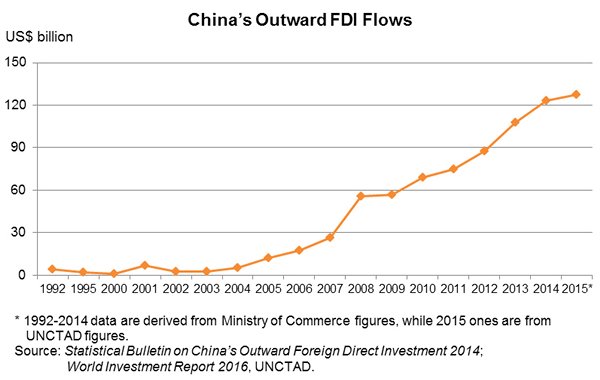
Meanwhile, China’s direct investment in Belt and Road countries is continually increasing, rising substantially from about US$400 million in 2004 to US$13.66 billion in 2014, an average annual increase of about 43%. Ministry of Commerce figures show that in 2015 Chinese enterprises made non-financial sector direct investment totalling US$14.8 billion (+18.2%) to 49 Belt and Road countries, accounting for 12.6% of China’s total non-financial sector direct investment that year. The investment flows were mainly directed towards Singapore, Kazakhstan, Laos, Indonesia and Russia.
It is worth noting that a considerable number of Chinese enterprises choose Hong Kong as their main channel for carrying out outbound investment – not only because Hong Kong is an international financial centre in the region with such advantages as free flow of capital. Abundant global communications and market network resources, as well as the availability of a complete range of professional services, are also key factors attracting mainland enterprises to use the Hong Kong platform in “going out”.
According to Ministry of Commerce figures, in 2014 the Chinese mainland routed US$70.9 billion in outward FDI through Hong Kong, accounting for 57.6% of the mainland’s total FDI outflows that year. Based on cumulative investment stock as at the end of 2014, the mainland has made US$509.9 billion in outward FDI through Hong Kong, accounting for 57.8% of the mainland’s outward FDI stock.[3]


Hong Kong: a Preferred Platform
Many cities and economic regions along China’s coast have been open to the outside world for many years. As China’s economy and investment outflows expand, coastal regions, provinces and cities, such as the PRD, YRD and Bohai Rim, have become main sources of outbound investment. On the other hand, with the western region including Sichuan province and Chongqing municipal benefiting from the Western Development strategy and other preferential policies, and with the efforts of provinces and cities concerned in attracting outside businesses and capital, the economy in the western region has been developing rapidly. Western China has always been an important gateway, a trading and logistics hub and an industry exchange ground connecting to Central Asia, South Asia and West Asia, and now enterprises in the region are also developing related investment and trading opportunities under the country’s “going out” and Belt and Road initiatives.
In May 2016, HKTDC Research conducted a questionnaire survey at the SmartHK fair held in Chengdu, the capital city of Sichuan province. As well as seeking to understand what challenges enterprises in western China are facing in their operations, the survey also aimed to find out about their intentions concerning transformation and upgrading, in “going out” to tap Belt and Road business opportunities, and their demand for professional services.
The survey followed similar studies carried out by HKTDC Research in the past three years in the PRD (2013), the YRD (2014) and Bohai Rim (2015) regions.[4] In the current survey, 237 effective questionnaires were completed by mainland enterprises (comprising trading companies, manufacturers and service suppliers) mainly from Sichuan, Chongqing and elsewhere in the western region.[5] The opinions of these 237 mainland enterprises on “going out” to tap Belt and Road business opportunities are outlined below.[6]


-
Challenges in Business Operations
Of the enterprises surveyed, 96% said they had come across different types of challenges in their operations in the past year. The three main problems they faced were (1) difficulties in financing; (2) rising labour, land and/or other production costs; and (3) a weak mainland market and inadequate orders. These accounted for 39%, 38% and 36%, respectively, of the enterprises surveyed.
In addition, 26% of the enterprises indicated they were worried about their lack of capability in product design and technological R&D; 22% pointed out that, in the face of keen competition in the international markets, they lacked competitive brands to help develop international markets and business; and 20% said they were affected by weak international markets and inadequate orders. By comparison, relatively few enterprises (only 9% of those surveyed) said the volatile renminbi exchange rate, including depreciation of the currencies in their target markets, was a hindrance.
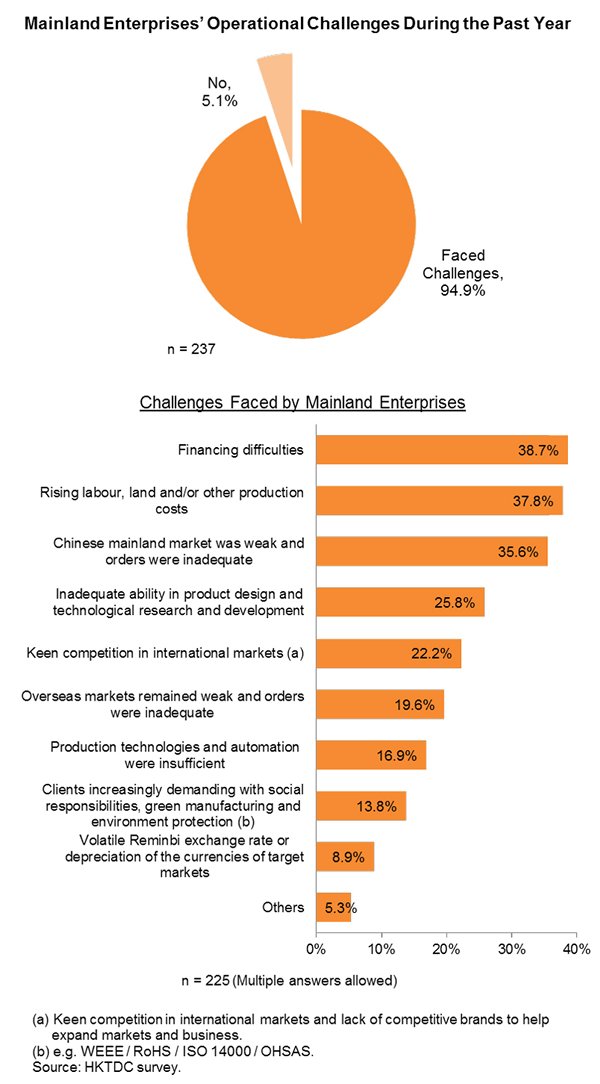
-
Adjusting Operating Strategy
Confronted with market competition and other challenges, 95% of the enterprises surveyed said they had already adjusted their business and operating strategies and made relevant investment, or would consider doing so in the next one to three years. As to the direction of adjustments in business and operating strategies, most enterprises indicated they would do more to develop overseas markets, accounting for 44% of all enterprises surveyed (including 29% saying they would do more to develop overseas mature markets and 25% saying they would do more to develop overseas emerging markets). In addition, 43% said they would develop/strengthen their own-brand business, while 41% said they would like to do more to develop the Chinese mainland market.
Compared with the results of previous surveys, enterprises in western China appeared to be as keen as their PRD counterparts in wanting to develop both overseas markets and the Chinese mainland market. In comparison, enterprises in the YRD and Bohai Rim regions were more concerned with bringing in foreign advantages to develop the mainland market, showing that the development strategies of enterprises in different regions were not all the same.
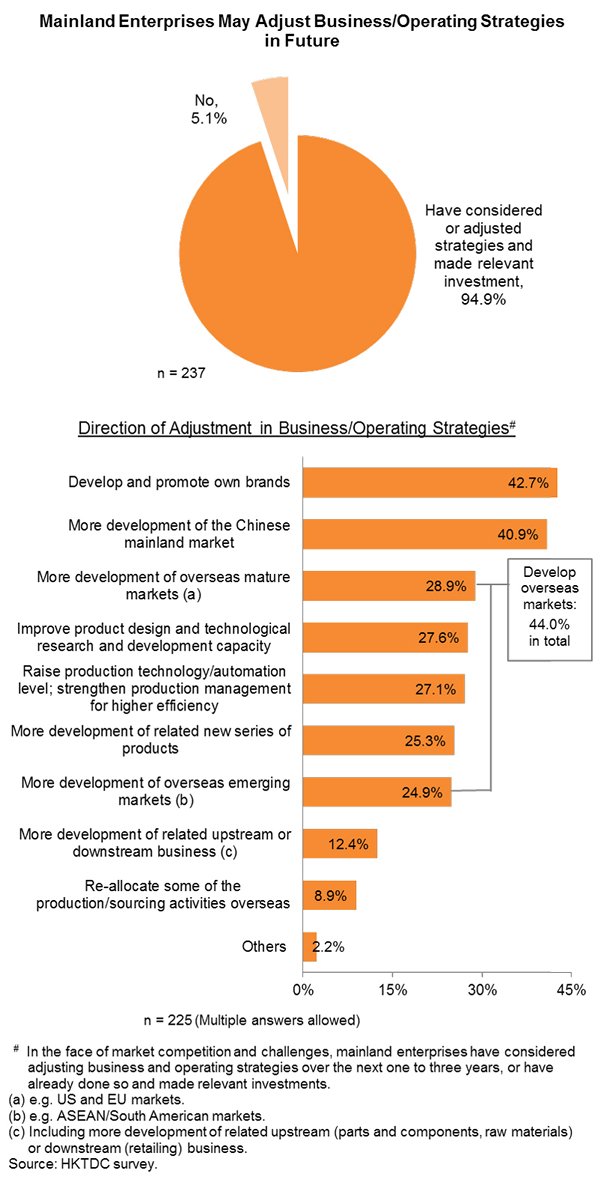
-
Intention of Tapping Belt and Road Opportunities
In the current survey, enterprises were also asked about their opinion on Belt and Road opportunities. Among all the enterprises surveyed, 81% said they would consider tapping opportunities in countries along Belt and Road routes in the next one to three years. Among these enterprises, most (65%) said they would like to sell more industrial products and light consumer goods to Belt and Road markets. A smaller proportion of the enterprises (34%) would like to go to Belt and Road countries to carry out sourcing activities, including the sourcing of consumer goods/food products to sell in the mainland market or the sourcing of raw materials for production on the mainland. Some enterprises (26%) would like to invest and set up factories in Belt and Road countries. In addition, 17% would like to set up transit warehouses in overseas locations including Belt and Road countries to enhance international logistics efficiency.
On the other hand, more than half of the enterprises (53%) said they would be most interested in going to Southeast Asia, such as ASEAN countries, to tap Belt and Road opportunities. Other locations of interest included South Asia (27%), Central and West Asia (20%), Central and Eastern Europe (19%) and the Middle East and Africa (18%).
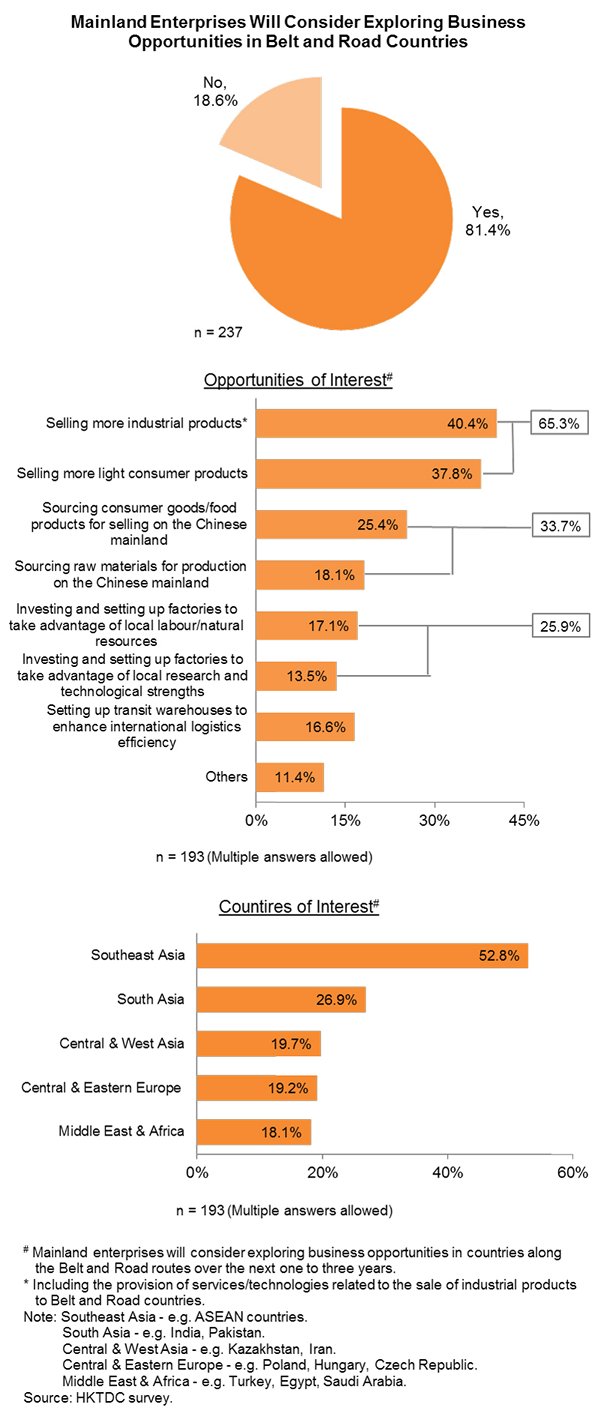
-
Keen Demand for Hong Kong and Overseas Services
Facing all types of business and operating challenges and aiming to advance transformation and upgrading, the enterprises surveyed were keen for various types of professional services. In line with the results of HKTDC’s surveys conducted previously in the PRD, YRD and Bohai Rim regions, the three main types of services most sought by western China enterprises were: (1) brand design and promotion strategy; (2) marketing strategy for the development of new business and new markets (including the development of Belt and Road markets); and (3) product development and design. These accounted for 46%, 45% and 44%, respectively, of the enterprises surveyed. This shows that, irrespective of the direction of transformation and upgrading of mainland enterprises or the focus of their operating strategies, the professional services needs of enterprises from different regions are more or less the same.
Other services western China enterprises need to seek from the outside included: marketing activities tailored to overseas markets, including Belt and Road markets (37%); financial services such as banking, financing and project valuation (36%); services in energy conservation, emission reduction and environmental protection technology (33%); and supply chain management and support services, such as materials and product inventory and logistics management (31%). Of those enterprises surveyed requiring these services, more than 60% indicated they would use the services provided by Hong Kong or overseas suppliers, with the exception of energy conservation and environmental protection technology.
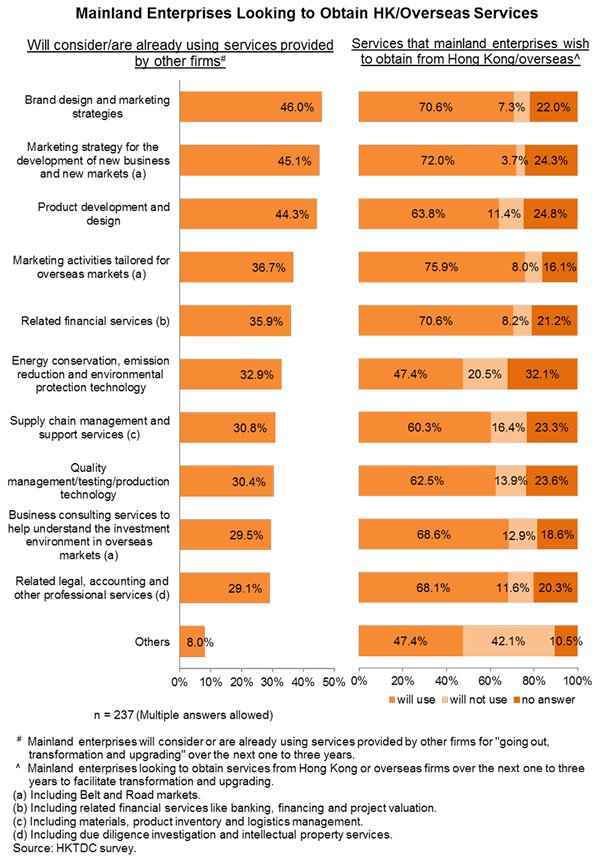
-
“Going out” To Seek Business Partners
Meanwhile, 81% of the enterprises surveyed expressed an interest in seeking, or had already “gone out” to seek, business partners overseas. The majority of the enterprises (about 50%) said they were interested in co-operating with foreign brands to increase sales. This is similar to the results from the surveys previously conducted in the PRD, YRD and Bohai Rim regions. (Coincidentally, enterprises from different regions considered brand co-operation as their top reason for seeking foreign partners.)
In addition, 22% of the western China enterprises surveyed said they would like to acquire minority equity stakes in foreign companies to expand their overseas/mainland sales networks, 20% would like to enter into technological co-operation with overseas institutions, while 15% would like to redouble their efforts in purchasing high-tech equipment, raw materials and key parts and components from overseas.
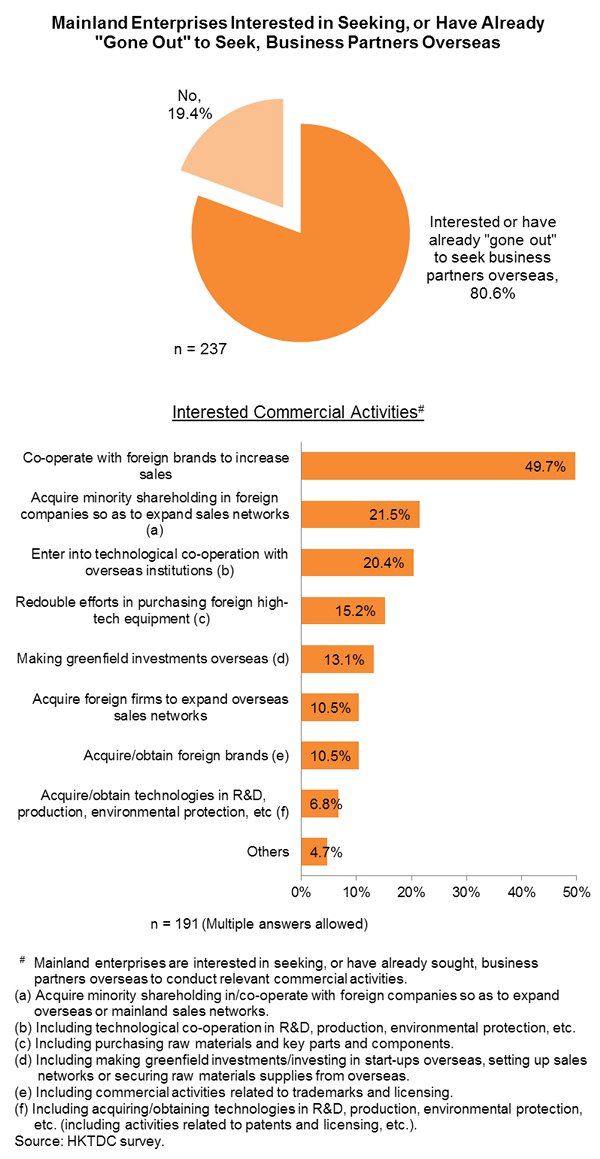
-
Hong Kong as the Preferred Services Platform for the Mainland’s “Going Out”
About half (50%) of the enterprises surveyed indicated they would like to go to Hong Kong to seek the professional services mentioned above and/or to look for foreign business partners. Although this proportion is slightly lower than in the previous three surveys, Hong Kong remains the “going out” platform preferred by most western China enterprises, and attracts the preference of a much higher proportion of enterprises surveyed than other locations such as the US, Germany, Taiwan, Japan and Singapore, which account for 26%, 20%, 19%, 17% and 14%, respectively, of the enterprises surveyed. It is therefore apparent that, irrespective of the location of a mainland enterprise or whether it is from the PRD, YRD, Bohai Rim or China’s western region, Hong Kong is the preferred services platform for “going out” from the mainland.
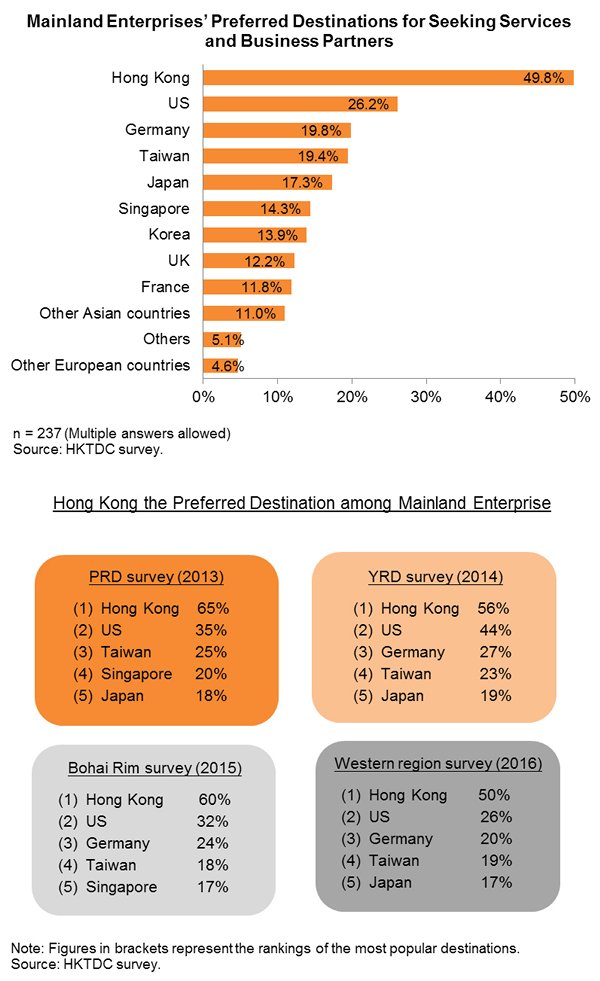
[1] The 13th Five-Year Plan refers to the Outline of the 13th Five-Year Plan for National Economic and Social Development of the People’s Republic of China adopted at the fourth session of the 12th National People’s Congress in March 2016.
[2] World Investment Report 2016, UNCTAD.
[3] Source: 2014 Statistical Bulletin of China’s Outward Foreign Direct Investment.
[4] For the research topics and results of the surveys conducted respectively in the PRD, YRD and Bohai Rim, please see Guangdong: Hong Kong Service Opportunities Amid China’s “Going Out” Strategy published in December 2013; China’s “Going Out” Initiative: Jiangsu/YRD Demand for Professional Services published in September 2014; and China’s “Going Out” Initiatives: Professional Services Demand in Bohai published in September 2015.
[5] The HKTDC held a SmartHK Expo fair at Chengdu Century City New International Exhibition & Convention Centre on 12-13 May 2016. During the CEO Forum and four thematic seminar sessions related to “going out” to tap Belt and Road opportunities, HKTDC Research conducted a questionnaire survey on the attendees. Of the 469 questionnaires collected afterwards, 237 were deemed to be effective ones filled out by mainland enterprises (including trading companies, manufacturers and service suppliers).
[6] The options in the current survey are slightly different from those in the three previous surveys, so only some of the results can be compared.
| Content provided by |

|
